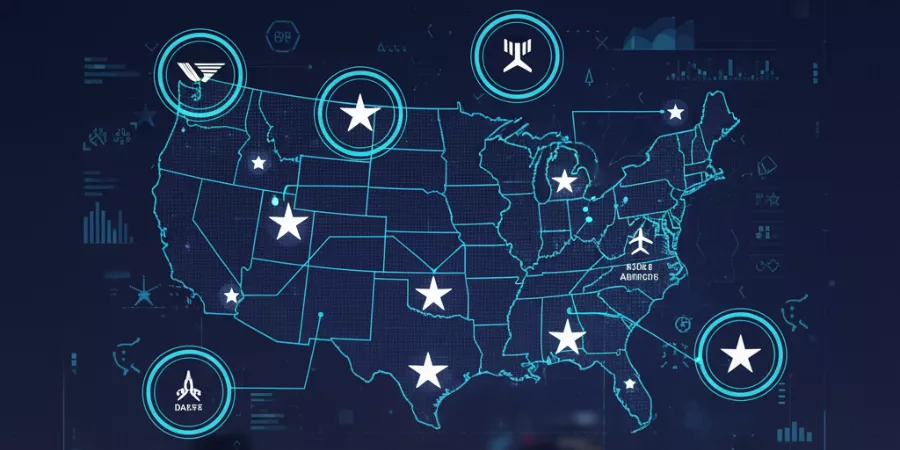The US grocery market spans hundreds of billions of dollars in annual spending, and a handful of grocery chains in the US command a disproportionate share. For example, industry data show that the top 5 grocery chains in the United States together account for roughly half of all U.S. grocery spending. If you work in retail analysis or you just shop regularly, it pays to know who the dominate players are and how they differ. Walmart, Kroger, Costco, Albertsons, and Aldi are among the largest supermarket chains in America, forming the grocery store market share in US.
Here we break down the top 5 grocery chains in the US, how they got there and what sets each apart.
1. Walmart
- Founded: 1962 by Sam Walton
- Headquarters: Bentonville, Arkansas
- Number of Stores in U.S.: Over 4,700
- Specialty: Large-format stores with grocery, general merchandise, and online integration
Walmart holds the lead by a wide margin. In 2025 the company is estimated to command about 21.2 percent of the US grocery market. One in every five grocery dollars in the U.S. is spent at Walmart. Its strength comes from an enormous store footprint, deep price competitiveness and an increasingly integrated online and in‑store grocery operation.
For shoppers that means convenience, the same retailer where you buy clothing and electronics also carries your week’s food shop. Real‑world analogy: like having your neighbourhood supermarket and general goods store rolled into one. Because of its scale, Walmart also wields supplier leverage, which helps it to offer low prices. The takeaway: Walmart’s scale creates both access and dominance.
2. Kroger
- Founded: 1883 by Bernard Kroger
- Headquarters: Cincinnati, Ohio
- Number of Stores in U.S.: Around 2,700 under multiple banners
- Specialty: Traditional supermarket model with private-label brands and loyalty programs
Kroger sits firmly in second place among traditional top supermarket chains. Recent estimates place its grocery store market share in US at roughly 8.8 percent in 2025. Founded in 1883 and now operating thousands of stores under multiple banners (Ralphs, Fry’s, King Soopers and more), Kroger has built strength via its private‑label brands, digital investments, and loyalty programmes.
For instance, if you think of a regional supermarket chains US brand you visit in your city, there is a good chance it is part of Kroger’s network. The chain is under pressure from large players, and a proposed merger with Albertsons made headlines. But as a traditional grocer, it continues to hold the second rung of the ladder. For shoppers it means you see Kroger banners in many states, often combining grocery, fuel and pharmacy under one roof.
3. Costco
- Founded: 1983 by James Sinegal and Jeffrey Brotman
- Headquarters: Issaquah, Washington
- Number of Stores in U.S.: Over 600 warehouse locations
- Specialty: Membership-based bulk purchasing with curated product selection
Costco holds third place when it comes to share among large national chains. Estimates suggest about 8.5 percent of the US grocery market is held by Costco in 2025. But the story is not just about market share, it is about format. Membership grocery stores like Costco operate on a warehouse model that emphasises bulk buying, higher basket‑size, and limited, curated selection.
The customers have to pay a membership fee that enables them to enjoy lower unit prices and easier shopping experience in the store. Due to this model, Costco has built loyalty and captured a strong niche. When comparing business models, Walmart stresses everyday low prices and vast selection, while Costco highlights membership benefits and bulk purchasing. The conclusion is that Costco proves that store format and loyalty strategy are crucial, not just the number of stores.
4. Albertsons Companies
- Founded: 1939 by Joe Albertson
- Headquarters: Boise, Idaho
- Number of Stores in U.S.: Approximately 2,200 under multiple regional supermarket chains USbanners
- Specialty: Strong regional presence with focus on local brands and community engagement
Albertsons has a number of regional supermarket chains US brands (like Safeway, Vons, Shaw’s, Jewel-Osco, etc.) and is projected to have about 6 percent of the market in 2025. The company mainly relies on its being present in local and/or regional markets to gain strength. It has been going through digital transformation, but at the same time, it grapples with consolidation and the challenge of competition from large companies.
Its proposed merger with Kroger was blocked on antitrust grounds, underlining how the grocery sector is now under scrutiny. For shoppers in regional markets, Albertsons‑affiliated stores often carry familiar regional brands and may feel more local. The takeaway: being large regionally still matters, but scale across the full national market becomes a differentiator.
5. Aldi
- Founded: 1946 in Germany by Karl and Theo Albrecht (U.S. entry in 1976)
- Headquarters: Batavia, Illinois
- Number of Stores in U.S.: Over 2,500 across about 40 states
- Specialty: Discount grocery stores like Aldiwith limited assortment, private-label focus, and lower operating cost
When considering store count or presence in the U.S., Aldi completes the top 5 grocery chains in the United States. Although there are differences between the exact market share estimates, one dataset predicts Aldi‘s market share to be approximately 3 percent in 2025. Aldi’s model is discount grocery stores like Aldi: limited assortment, smaller footprint, private label focus, and lower operating cost. It has more than 2,500 locations in the United States across about 40 states.
For shoppers seeking lower price basics and no‑frills experience, Aldi offers a compelling alternative. In the analogy of grocery formats, Aldi is the streamlined budget champion, while Walmart is the broad‑assortment giant, Costco the membership-bulk player, Kroger the traditional supermarket, and Albertsons the regional stalwart.
What this really means
When you step back, several themes emerge from this ranking of the largest supermarket chains in America.
- First: scale brings advantage. Walmart’s size and reach give it unmatched influence.
- Second: format matters. Costcoand Aldi show that model choice, membership bulk or discount limited‑assortment, influences how consumers shop.
- Third: regional strength continues to count. Albertsonsshows that you do not need to be the absolute biggest in national share to matter.
- Fourth: digital, omnichannel and private label all matter for the next wave of competition. Kroger’s investments reflect that.
For anyone working in retail, marketing or consumer behaviour, the takeaway is clear: being among the top 5 grocery chains in the United States demands scale, format clarity, and value proposition. For consumers it means that a large portion of grocery spending flows through a small set of grocery chains in the US, which shapes pricing, assortment, and store experience.
For example, if you live near a Walmart, you might see price pressure and assortment influenced by that chain’s national supply network. If you live near an Aldi, you might experience a leaner offer but consistently lower cost.
Finally, the ranking also suggests where disruption might come from. Smaller regional supermarket chains US, niche formats (organic, local) or digital‑only models may carve out space, especially if consumers demand something different from the large national players. The takeaway for you: when you hear largest supermarket chains in America, remember the names Walmart, Kroger, Costco, Albertsons, and Aldi, and understand what makes each one tick. Their differences define much of how Americans shop for food.














